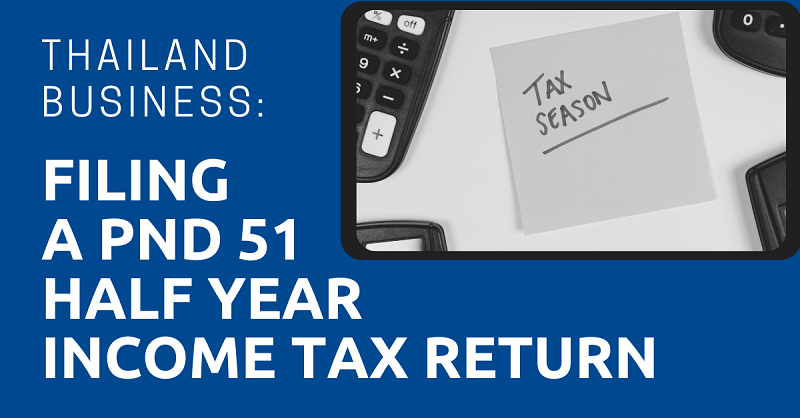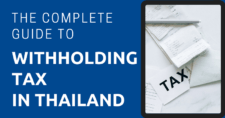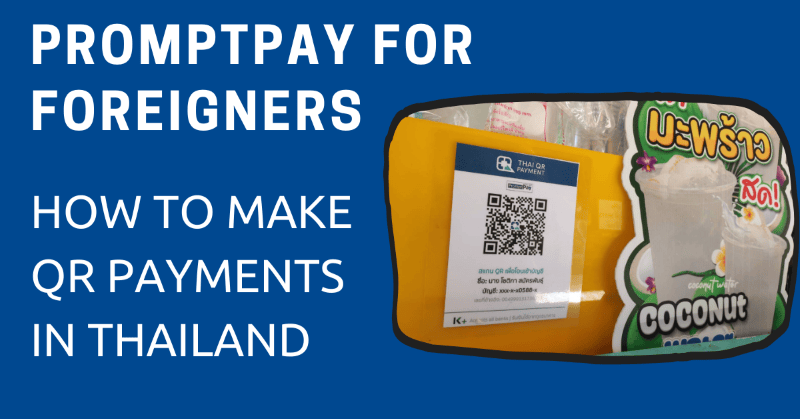
When I first moved to Thailand in 2014, cash was king. But over the years, the country has been moving toward becoming a cashless society.
Restaurants like Swensen’s and coffee shops such as Starbucks no longer accept cash. Even certain fast-food chains would rather you pull out a debit or credit card or scan with your bank app than pay with paper money.
That’s not to say you can’t get by with only cash. In fact, it’s still how I pay for a majority of things in Thailand. Having said that, I do use PromptPay once in a while because it’s more convenient than running to an ATM.
In this guide, I’m going to show you how to get PromptPay on your phone, walk you through setting it up, and give you a few alternatives if you’re a tourist who doesn’t have a Thai bank account but want to pay like a local.
"*" indicates required fields
Disclaimer: This article may include links to products or services offered by ExpatDen's partners, which give us commissions when you click on them. Although this may influence how they appear in the text, we only recommend solutions that we would use in your situation. Read more in our Advertising Disclosure.
Contents
- What is PromptPay?
- What You Can Pay for Using PromptPay
- Setting up PromptPay as a Forienger
- Paying with PromptPay
- Sending and Receiving Money with PromptPay
- Other QR Payment Methods for Foriengers
- PromptPay Fees
- QR Payment Fees Vs. Traditional Payment Fees
- Advantages of Using PromptPay
- Disadvantages of Using PromptPay
- Privacy Trade-offs
- Now, on to You
(And How It’s Costing Them)
Most expats throw money away, get lost in red tape, and miss the local hacks that make life easier and cheaper. ExpatDen Premium gives you the secrets seasoned expats use to save, earn, and thrive beyond the basics, saving you thousands and opening doors you didn’t even know existed.
Here’s what’s inside:
- Housing Hacks: Slash your rent by 40% or more - because the locals are laughing at what you’re paying.
- Banking Mastery: Stop wasting on fees and get top exchange rates. Why give your money away?
- Healthcare for Local Prices: Quality treatment without the expat price tag.
- Visa and Legal Shortcuts: No more bureaucratic nightmares. Get the visa and residency secrets that others pay their lawyer dearly for.
- Deep Discounts: Find the savings locals rely on for groceries, dining, and more.
If you’re serious about making Thailand work for you, join ExpatDen Premium and make Thailand work for you.
What is PromptPay?
PromptPay is the most popular digital payment system in Thailand. It’s essentially the Bank of Thailand’s interbank payment system. With it, you can send or receive money through any other bank in Thailand, whether that bank is the same as yours or not, and with no added fees.
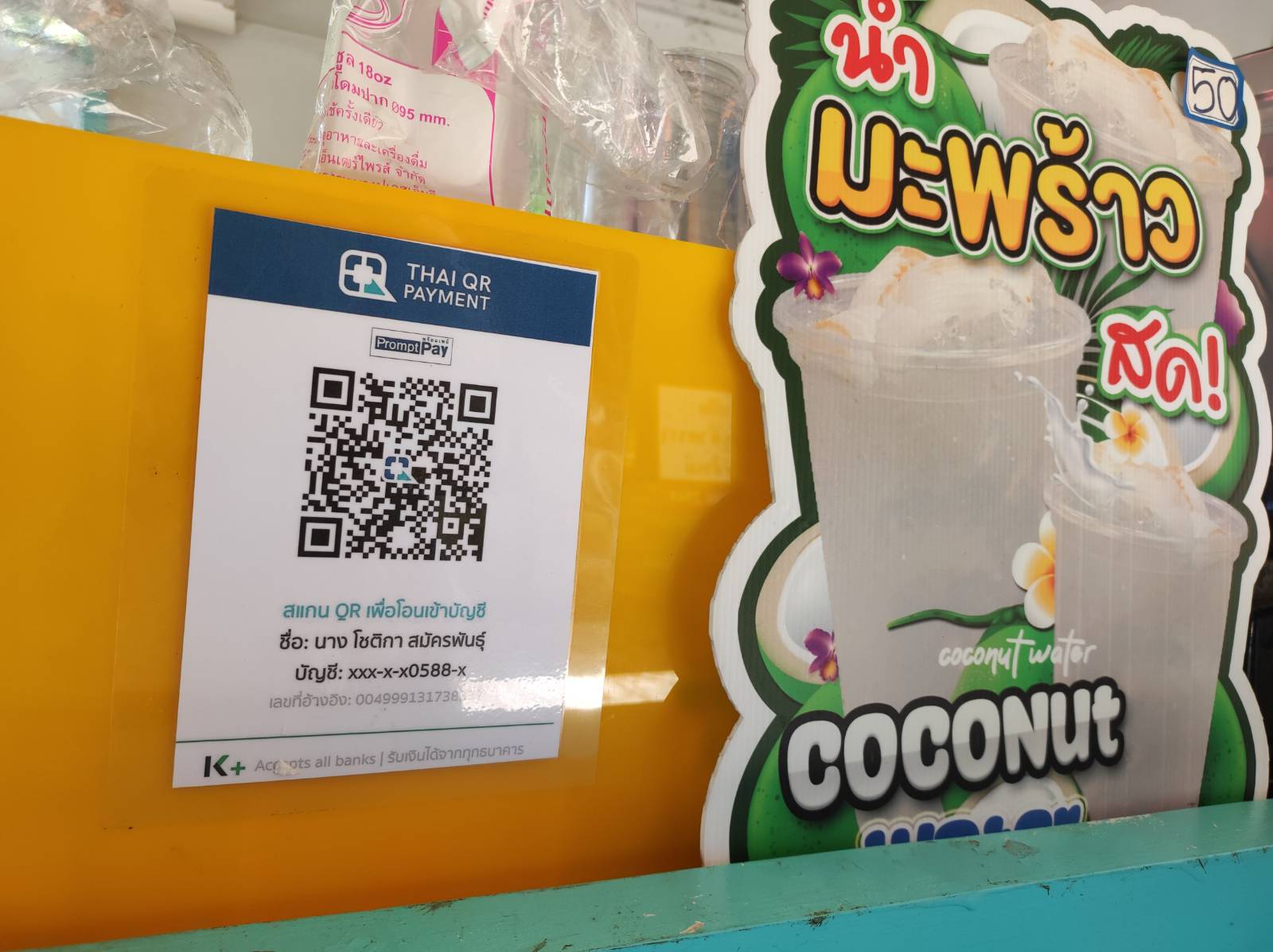
What You Can Pay for Using PromptPay
In Thailand, there is no limit to what you can and can’t pay for using PromptPay. Here are some of the things I’ve used it for over the years.
- Goods: Clothes from department stores at malls, school supplies for my daughters from B2S, vinyl records from Fortune Town.
- Services: Thai massages and doctors’ visits.
- Utilities: Electric bills.
- Grocery bills: Villa, Tops, Foodland, Makro, Lemon Farm, Central Food Hall, and other major supermarkets.
- Restaurant and bar tabs: Mostly every place that I’ve eaten at has the option to pay using PromptPay.
Believe it or not, you cannot use PromptPay to pay your bill at 7-ELEVEN. For that, they deal exclusively with TrueWallet, which I’ll cover below.
Setting up PromptPay as a Forienger
When you have a Thai bank account and mobile banking app, you’ll automatically have access to PromptPay. So, technically, you don’t have to set up PromptPay; it’s included in your app. That said, here are the steps to take from the beginning.
If you already have a Thai bank account, you can move onto the Download the Mobile Banking App section. If you don’t, continue reading.
Open a Thai Bank Account
The first thing you need to do is open a bank account in Thailand. Because the process requires specific documents and requirements, I won’t go into detail here. For that, you can check out our in-depth guide to opening a Thai bank account written by ExpatDen founder Karsten Aichholz. He covers everything you need to know.
Download the Mobile Banking App
Once you have a Thai bank account, you have to download the accompanying mobile banking app and register it. The registration process usually includes adding your passport number and scanning your face for security reasons.
This is where you might meet a few challenges though. In my experience with mobile banking apps in Thailand, the facial scanning feature never works. After every app update every few months, I’m forced to go to the bank and re-register my app in person. I asked a few times why this keeps happening, and the only response I got, believe it or not, was that the system doesn’t do a good job at scanning non-Asian faces.
To avoid being one of the unlucky few like myself, download and register your mobile banking app while you’re at the bank, preferably when opening your account.
With your Thai bank account open and app registered, you can begin using PromptPay to make payments and receive money.
Paying with PromptPay
Most Thai banking apps have a “scan” feature in the app. In my Krungthai NEXT mobile banking app, it’s the large blue button at the bottom of the front screen. Depending on your mobile banking app, your scan button might be located somewhere else.
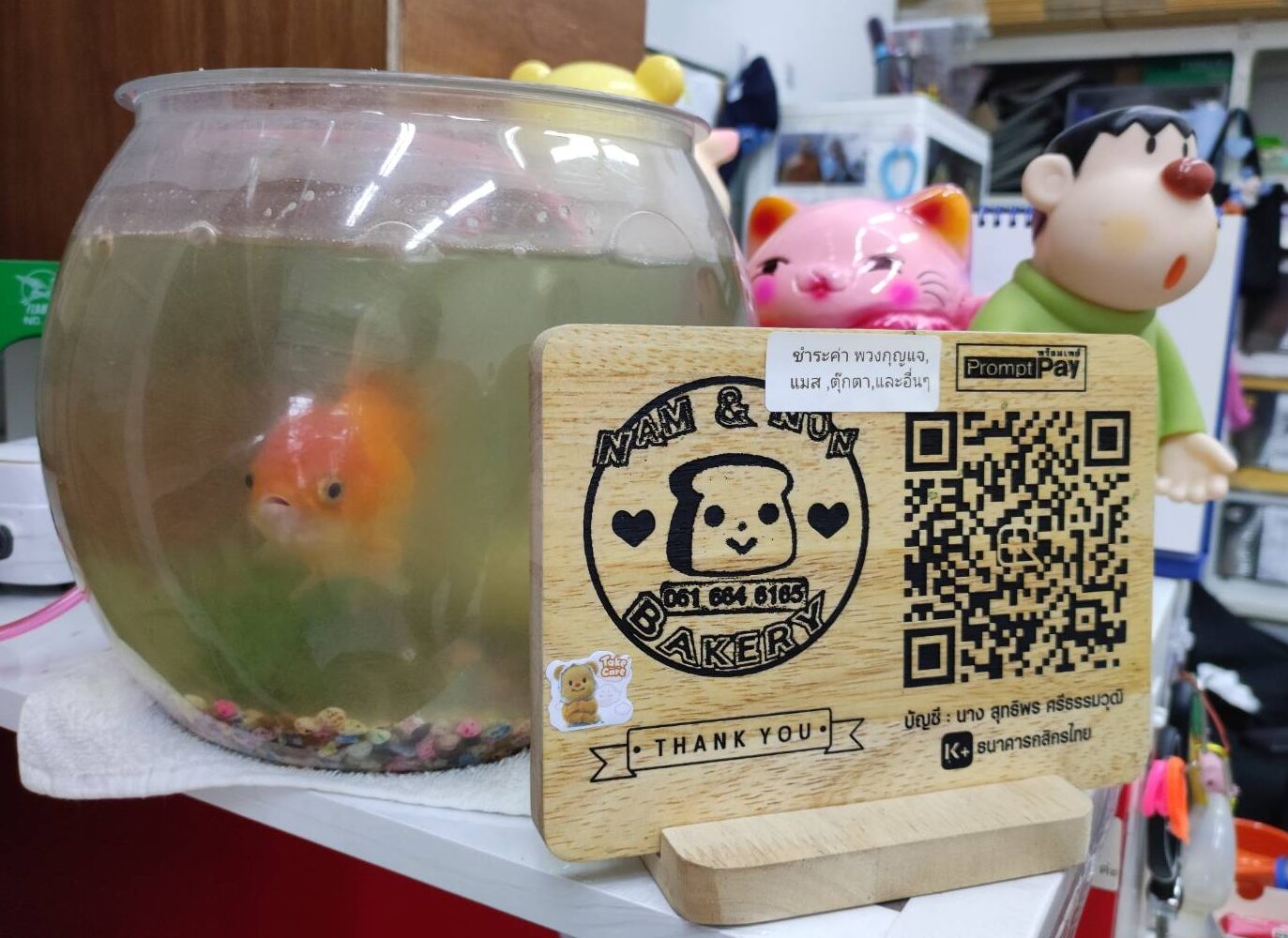
Either way, once you tap the scan button you will be taken to the bank app’s camera function, whose only purpose is to scan QR codes. Point the camera at the QR code you want to scan, and the app should recognize it instantly. You’ll then be brought to the payment screen where you can either confirm the amount you have to pay or add the amount yourself and check the recipient.
For instance, when I pay for papaya, som-o, and other fruits from the vendor down the road, she tells me the total, then I scan her QR code, add the amount to the app, and confirm the payment. If I take my kids to eat at Fuji restaurant, the restaurant generates a custom QR code for my dinner that includes the amount I have to pay.
Whether you have to add the payment yourself or it’s already there, you then have to confirm the payment amount and recipient before hitting send. Check that everything is correct, then hit confirm. At this point, you’ll have to enter your pin code for security verification.
When the payment goes through, usually instantly, don’t close out the screen. Show the receipt to the vendor or cashier. He or she may want to take a picture of it for their records. A copy will also be saved to a dedicated folder on your camera’s photo app. So if you do happen to close out the app before showing the receipt, check there.
Sending and Receiving Money with PromptPay
Sending money with PromptPay is just as easy as paying with it. Open your mobile banking app, select the transfer option, and you’ll see PromptPay listed as one of the choices. Enter the cell phone number of the recipient and the amount you want to transfer. Then enter your PIN and hit send.
You can receive money the same exact way. You just have to give the sender your phone numbered that is registered with PromptPay. It’s the same phone number you used to open your bank account and register the mobile banking app with.
Other QR Payment Methods for Foriengers
PromptPay is the most popular digital payment system in Thailand for locals and expats with Thai bank accounts. Unfortunately, it’s not available to those without Thai bank accounts or those who are in Thailand for short-term stays.
If you’re in Thailand as a tourist or on the Destination Tourist Visa, you have a few other options. But they come with some catches. Keep in mind these are newer services. I have never used then, nor has anyone I know. If you decide to use them, do your due diligence.
TAGTHAi Easy Pay
TAGTHAi Easy Pay is an e-wallet marketed toward tourists in Thailand. To set up an account with TAGTHAi, you have to download the app. Once you register, you can top up your account by exchanging foreign currency for Thai baht at Kasikornbank (KBank) Foreign Exchange booths and loading it onto your TAGTHAi account. You can find Karikorn banks booths at many airports, BTS stations, and inside department stores.
After linking the card in the app, you can then scan PromptPay QR codes in Thailand to pay at restaurants, malls, street markets, and most other places that accept QR payments.
If you get the TAGTHAi Pay & Tour pre-paid card, you can even withdraw up to THB10,000 per day from ATMs in Thailand.
TouristDigiPay
Thailand just launched TouristDigiPay in August 2025. This lets foreign tourists convert cryptocurrency into Thai Baht for electronic spending through QR code payments. To participate, you must open an account with both a Securities and Exchange Commission-regulated digital asset business and a Bank of Thailand-licensed e-money provider. Also, it’s only going to be available for visitors on temporary stays.
Because the program is so new, we will update readers here as more information becomes available about costs, providers, and user experiences.
True Wallet
True Wallet, also known as TrueMoney Wallet, is a Thai e-wallet that opened up to foreign tourists in mid-2024 but works better for Thais than expats. That said, it does support paying by QR code with PromptPay throughout Thailand.
To set up an account, you need to download the app and complete the registration process, which you can do with your passport. The main limitation is that you can only top up with cash at 7-ELEVEN stores, with a maximum of THB3,000 per transaction. This means you have to make multiple transactions for larger amounts.
Given the cash-only method of funding the e-wallet, many expats find it’s not worth the hassle compared to just using cash for payments.
WAIWIN
WAIWIN is a new tourist-focused app from Australia that lets users scan and pay through QR codes in Thailand. You have to download the app, top up your balance using your bank, Wise, Revoult, or more. Then you can begin using the app to scan and pay like a local in Thailand.
DeepPocket
DeepPocket is another app that lets you scan and pay using QR codes in Thailand. At the time of this writing, it doesn’t have many positive reviews, so I’d avoid using it at all costs. I’m only mentioning it here because I’d rather you know ahead of time to avoid it.
PromptPay Fees
When you use PromptPay to buy everyday goods, you won’t pay any fees unless you spend over THB5,000. But even after that amount, the fees aren’t extraordinary. The table below shows the spending amounts and associated PromptPay fees as listed by Krungthai Bank.
| Purchase Amount | PromptPay Fee |
|---|---|
| < 5,000 | Free |
| 5,000 to 30,000 | 2 |
| 30,000 to 100,000 | 5 |
| 100,000 + | 10 |
QR Payment Fees Vs. Traditional Payment Fees
If you have a Thai bank account and use PromptPay to scan and and pay, you won’t incur any additional charges.
This makes it a better option than withdrawing money from a Thailand ATM, especially if you’re in a province where you didn’t open your bank account. In this case, you’d have to pay a small fee, usually THB15.
For international withdrawals, you’ll pay a THB150 to THB220 fee per withdrawal. So it’s better to top up an e-wallet once than withdraw multiple times while losing money on unfavorable exchange rates.
As for credits cards, most companies charge an average 3 percent fee for international payments.
| Payment Method | Setup Cost | Transaction Fees | Top-up Method | QR Code Support | User Experience | Best For |
|---|---|---|---|---|---|---|
| PromptPay (Thai Bank) | Free | Free under THB5,000 | Direct bank transfer | All QR codes | Instant, universal acceptance | Long-term expats |
| TAGTHAi Easy Pay | Free | High forex fees and poor exchange rates | Currency exchange at KBank booths | Business QR only | Slow app, limited acceptance | Tourists (limited use) |
| WaiWin | Free | Unknown fees | Wise transfers; email support required | All PromptPay QR codes | Poor support, setup issues | Tech-savvy tourists |
| Internationl ATM | N/A | THB150 to THB220 per withdrawal + home bank fees | N/A | Cash only | Queue time, location dependent | Cash backup |
| Internationl Credit Cards | N/A | 3% merchant surcharge + forex fees | N/A | Limited acceptance | Accepted in tourist areas | Tourist areas only |
Considering all this, you can see why PromptPay is the next cheapest option to paying for goods and services in Thailand after good ole fashion paper cash and coins.
Advantages of Using PromptPay
Most people who use PromptPay do so simply for the convenience. But there are some other advantages to using it as well.
- Safer than cash: You don’t have to worry about losing cash or being robbed for cash. A friend of mine was once withdrawing money from an ATM along Sukhumvit Road late at night. Some men came from behind him with a knife and demanded that he keep removing his money until he hit his withdrawal limit. Then they stole his money. This is the only time I’ve heard of someone I know getting robbed in Bangkok, but it makes using PromptPay a much safer alternative.
- App security: Banking apps require biometric and PIN authentication. This means no one can use PromptPay within your banking app unless you’ve registered it first. And you have to do this by scanning your face, as I already mentioned. They also won’t be able to use PromptPay in your banking app without your PIN.
- Transaction limits: Some banks set daily and monthly limits to protect you against fraud. But some people consider this more of a disadvantage than advantage. Either way, you will have some peace of mind knowing that in the worst case scenario, no one can wipe out your bank account through PromptPay in one shot.
Disadvantages of Using PromptPay
Digital payments may offer convenience, but relying solely on PromptPay can lead to issues down the road. Here are some that I’ve faced over the years when trying to use PromptPay.
- Doesn’t work while on wifi (sometimes) or VPN (always): I’ve found that my Krungthai NEXT banking app doesn’t work while I’m on a VPN or sometimes when I have my wifi toggled on. I have to remember to toggle both of these off before opening my app, which defeats the purpose of having a VPN. Sometimes I have to retry many times while there are other people waiting to pay.
- Suspended bank accounts: One time my Thai bank account was suspended, and I lost access to my mobile banking app. I had no cash on me as well. This left me in a bad position until I got to the bank.
- Poor cell phone coverage: My kids and I like to go camping quite often. In some rural areas, the cell phone service isn’t that good. It’s harder to pay using PromptPay. That said, coverage is getting better these days. Even remote coffee shops at the top of Khao Yai can accept PromptPay transfers.
- Service outages: My one friend uses Siam Commercial Bank (SCB), and his mobile banking app stops working after midnight for some reason. On more than one occasion we watched Muay Thai fights, went out for food afterward, and I had to cover his bill until he could transfer money to me the next day because his app stopped working.
- Financial discipline: Sometimes you don’t realize how much money you spend until you get home and calculate all your receipts. When you have cash on you, you can feel the cash disappearing throughout the day. PromptPay makes it easy to get directly into your bank account and spend money freely.
I’m not telling you these things so that you avoid using PromptPay; I’m just saying that you should make sure you always have a THB1,000 note stashed in your wallet or car for emergencies.
Privacy Trade-offs
With convenience there always comes a trade-off, and it’s no different with digital payments and PromptPay.
Yes, it’s safe and secure and you don’t have to worry about losing cash or carrying lots of money around with you. But keep in mind when you use digital payments, here are some of the things that are collected about you at the bank and government level:
- Transaction data, including every purchase amount, location, time, and merchant
- Person-to-person transfer patterns
- Bill payment history including utilities, government services, and even taxes
- Identity, including the 13-digit ID number, which is tied to your bank account, creating a permanent link between your identity and all your financial activity
- Phone number, creating additional tracking abilities
I am not presenting these details to scare you away from using PromptPay. As I said, I use it myself. I just want you to see the full picture so that you can make an informed choice about how you pay for goods and services in Thailand.
Now, on to You
Using PromptPay in Thailand is easy if you already have a Thai bank account. All you have to do is register your mobile banking app to begin using it. If you don’t have a Thai bank account, then you might want to looking into using TAGTHAi or WAIWIN. Either way, once you’re up and running with a digital payment system, you can begin scanning QR codes and paying for things in Thailand just like a local or long-term expat.




